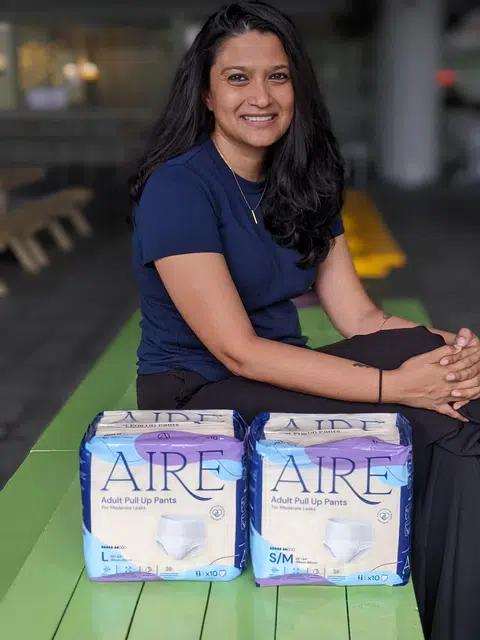More than half of older women in Singapore face bathroom woes
A 2020 study of more than 1,100 healthy women aged 45 to 69 found that 52.3 per cent have symptoms of urinary incontinence.
One day in July 2024, Madam Foo Kim Wah had the uncontrollable urge to urinate. She could barely make it to the bathroom.
Soon, her incontinence grew worse. She soiled her clothes. She had to change and wash her pants up to four times a day.
"I was so scared, I couldn't sleep at night," recalls Madam Foo, who turns 73 in 2025 and works part-time as a retail promoter.
Incontinence threatened her daily routine and quality of life. She could not go out to exercise on the outdoor machines near her home, like she normally did for an hour in the morning. She was afraid to go to work or do housework. She did not want to start wearing adult diapers either.
Madam Foo lives with her son and his family, but was embarrassed to tell them about her condition.
She did not think that she could get to her usual polyclinic without soiling herself, so she visited a nearby general practitioner instead. She was told that her incontinence could be because of her age, as well as a urinary tract infection (UTI).
She took medication for the UTI, which addressed the uncontrollable urge to urinate. She also made an appointment at Kallang Polyclinic for follow-up care. "I wanted to learn how to hold it in, in case one day I cannot," she says.
More than half of older women here face bathroom woes, even if they are otherwise healthy, according to local research.
A study of more than 1,100 healthy women aged 45 to 69, published in 2020 in the International Urogynecology Journal, found that 52.3 per cent have symptoms of urinary incontinence.
Another problem that older women face is voiding difficulty, where the flow of urine is intermittent or the person feels that the bladder is not emptied after urination. While there is no data on how prevalent this condition is, voiding difficulty can occur when women suffer pelvic organ prolapse.
Embarrassment can make it difficult for women to talk about problems such as incontinence or voiding difficulty. Solutions such as diapers may seem infantilising, while surgical intervention seems troublesome.
Some might also dismiss early symptoms as not worth worrying about.
A few weeks before Madam Foo faced such difficulty with incontinence, she had in fact refused an offer of treatment for the condition at Kallang Polyclinic.
While being screened for cervical cancer last June, she had been identified as having incontinence issues and referred for further care.
At that time, she had declined the referral, thinking that her symptoms were mild. She took home only educational pamphlets on dietary and lifestyle habits that could help her manage the incontinence.
The UTI made her realise the importance of receiving treatment for incontinence. After being seen by a doctor and a nurse last September, she embarked on a regimen which included doing pelvic floor exercises and adjusting her daily fluid intake.
As she also had faecal incontinence, she was referred to a hospital for a colonoscopy to rule out cancer. Later, the doctor recommended topical oestrogen to treat her symptoms as well.
She says she has no problem with urinary incontinence now and even the symptoms of faecal incontinence have subsided.
She used to have to cut short her morning hour-long exercise routine in order to come home and use the toilet. "Now, I can hold it in," she says.
Why women are prone to incontinence
Women are more prone to incontinence than men, according to studies around the world.
Doctors say that this is because pregnancy and childbirth, as well as the hormonal changes during menopause, affect the pelvic tissues and organs.
Dr Ong Ai Li, family physician and associate consultant at Kallang Polyclinic, typically sees women aged 50 to 70 with urinary incontinence.
"After menopause, lower oestrogen levels cause the tissues around the bladder and urine tube to become thinner, drier and less stretchy, which weakens control over urination and increases urinary symptoms," she says.
"Hormonal changes can also make the bladder more sensitive, causing sudden urges to urinate and waking at night to pass urine," adds Dr Ong, who is adviser to the women's health specialty advisory group at the National Healthcare Group Polyclinics.
As vaginal and urinary tissues dry and shrink, patients may experience the urge to urinate more often, she says.
With weaker muscles supporting the bladder, urine may leak during activities such as coughing, laughing or exercising. This phenomenon is known as stress incontinence.
Other types of incontinence include urge incontinence, which involves a strong desire to urinate. Patients may void their bladder before reaching the toilet.
Mixed urinary incontinence is a combination of stress and urge incontinence.
Stress incontinence and mixed incontinence are the most common types in Singapore, according to the 2020 study, each affecting 20 per cent of women.
Non-pharmacological management of incontinence often involves losing weight to reduce pressure on the bladder; adjusting the amount of fluid taken; and retraining the bladder to suppress the urge to pee. This can be through relaxation techniques or doing pelvic floor exercises.
Dr Ong says that urinary incontinence is often underreported due to embarrassment or the belief that symptoms are a normal part of ageing.
She suggests that women who notice symptoms of incontinence track their symptoms for two to four weeks. Information about the frequency of urination, the amount of urine produced, fluid intake and any instances of incontinence can help the doctor come up with an appropriate treatment plan.
"However, if they notice any red flags, such as blood in the urine, severe pain or sudden changes in urinary habits, they should seek medical attention immediately."
The business of incontinence
In 2011, researchers from the University of North Carolina estimated that over 400 million people over the age of 20 around the world experience some form of urinary incontinence. The number is likely to rise as populations age.
For Singaporean entrepreneur Nivedita Venkateish, this translates to an untapped multi-billion-dollar market for incontinence products in Asia alone. In 2023, she launched Singapore brand Aire, which makes adult diapers and absorbent pull-up pants.
"My friends joke that I went from AI (artificial intelligence) to AI (adult incontinence)," says Ms Venkateish, who turns 36 in 2025.

Her 94-year-old grandmother suffers from incontinence, but does not want to wear diapers. The older woman finds existing products too rough on her skin.
"She also said she doesn't want to wear what babies wear," recalls Ms Venkateish.
Ms Venkateish started by developing products that use only breathable cloth instead of the typical plastic backing most adult diapers have.
She also helps organise educational events to introduce people to the dietary and lifestyle changes that can help manage incontinence symptoms.
Incontinence affects every aspect of a person's life, she says. "You feel like there is something wrong with you. You feel ashamed and embarrassed to go out. In Asia, it's still very stigmatised."
Prolapse and voiding difficulty
Besides urine leakage, women are also susceptible to the reverse condition: voiding difficulty.
Dr Han How Chuan, obstetrician and gynaecologist at Mount Elizabeth Novena Hospital, explains that this is when passing urine becomes abnormally slow and intermittent. Patients may not feel they have completely voided their bladder after going to the bathroom.
Voiding difficulty can be caused by post-menopausal changes to the vagina, genital and urinary tract. It can also be caused by the prolapse of the bladder.
A prolapse occurs because the pelvic floor no longer adequately supports the organ, which then descends and protrudes into the vagina. In the case of vaginal prolapse, the part of the vagina weakens and descends.
Menopause and pregnancy can cause the pelvic floor to weaken. Obesity and lifting heavy objects can also increase the risk of prolapse.
Dr Han says that some of his patients with prolapsed organs may need to manually shift the protruding tissue in order to urinate.
Among them was financial adviser Eileen Seah, 56, who is married and has four sons. She suffered a vaginal prolapse and a bladder prolapse in 2022, probably after lifting something heavy while doing housework.
It was like having a "giant fishball" protruding from her vagina, she says. It blocked the passage of urine and made going to the bathroom uncomfortable.
Used to doing high-intensity exercises, she now found it irritating to even walk. Any exertion made the prolapse worse.
"When I walked, I felt like something was there, rubbing at me. When I sat, it would be pushed back in but when I stood again, it would come out," she says.
She had to have surgery in 2024 to address this. A mesh sling was put in to support the vaginal wall and push the tissues back into place.
Another of Dr Han's patients, a retired tea lady who wanted to be known as Madam Lee, urges women with voiding difficulty or other bathroom woes to seek medical treatment immediately.

In 2023, the 70-year-old had a mesh put in to repair prolapses of the vagina and bladder. The latter made it difficult for her to urinate. Unlike many other women, she was not embarrassed to seek medical help.
"I saw the doctor because I wanted to be sure that it was not cancer," she says in Mandarin, through an interpreter. "There's nothing to be shy about. Health should be your priority."
Akshita Nanda for The Straits Times